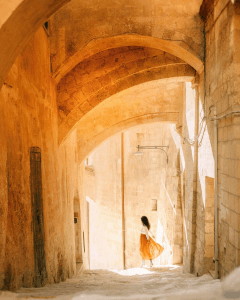How did you author the photo you recorded for upload to Instagram?
This photo was taken on and edited on the Instagram app on my iPhone 6S using its rear facing camera.
This door is just beyond the grand archway of the Old Melbourne Gaol, right near Building 13. In comparison to the archway, it looked so plain, but refreshingly simple
In today’s tutorial, Nash asked us to decide on a theme for our Instagrams. For mine, I have chosen not quite a theme, more of an aesthetic. My photos on my Instagram page will be of closed doors, placed on the right of the frame. I will use rather heavy handed colour editing and a linear blur to highlight the door. (See my video post for this week for my theme/aesthetic for the videos on my blog.)
The lighting was a little off for this photo, resulting in the very bright front step of the door. However, this allowed me to incorporate a lot of greenish-yellow into the photo using the ‘Colour’ feature and picking yellow for the highlights. Other edits I made included: choosing red for the shadows, straightening up the photo using the ‘Adjust’ feature, adding a vignette and that linear blur to emphasise the door.
I don’t think this photo is as visually appealing as last week’s, but I’ve already deleted a few photos in an attempt to adhere to my theme; I don’t feel like deleting another.
Manovich (2016) writes that ‘visual characteristics…are not carefully controlled, so from the point of view of proper good photography these are often (but not always) bad photos.‘ (Manovich 2016, p.52)
My mother picked up photography when she picked up scrapbooking (they kind of went hand in hand) and she always told me, don’t put your subject right in the middle, put them a little bit off to the side. Something about the rule of thirds. So maybe I am following some rules of ‘good photography’, but there is something certainly off about that lemon-lime coloured highlight on the step.
But, eh, I like colours. I need something to contrast my black and white silent videos.
In the reading, Manovich (2016) writes, ‘the content of casual photos is more important to their users than following the rules of good photography’ (Manovich 2016, p.52).
I totally agree.
I felt a little restricted by the instruction to decide upon a theme, but I understand that it’s required to carve out a niche and find an audience on Instagram. It’s a part of learning to use the platform and one day I might find a topic where theme, aesthetic and content all align beautifully.
But with content like doors and no metaphors allowed?
…I’m doing my best. (#amithematicyet)
How did you publish the photo you recorded for upload to Instagram?
Originally, I took photos of the large archway nearby to this door, then decided it was too extravagant for my quaint little Instagram page. So instead I stumbled upon this door. I took several photos of it, some with it centred, some with it pushed over to the right so I could see the edge of the window next to it. Seeing that photo, with the bright window peeking in from the left, echoing the orange clouds on the projector from last week, it helped me decide on the theme/aesthetic for my photos.
An interesting quote from Part 1 of this week’s reading: ‘The documentation function was integral to photography from its beginning in the 1830s, but Instagram intensifies it. Instagram interface shows the date and time for each photo and exact location’ (Manovich 2016, p.52)
I tagged this photo at the Old Melbourne Gaol because I think it’s rather cool I go to uni right next to such a historical site, despite the fact that I never go there to appreciate it. Maybe I should’ve geotagged my exact location, so that my small handful of viewers can find this ‘lonely’ door.
In terms of captions, I want my photos to all have one word title/captions. Last week’s was ‘Exit’, this week’s is ‘Lonely’. I like how they leave much unsaid and allow the viewer to draw their own interpretations.
Along with my usual slew of hashtags (one for the class, one for the uni, one for the content, and one for my thoughts), I added one for the Old Melbourne Gaol, to further emphasise the location.
How did you distribute the photo you published on Instagram to other social media services?
Having linked up my Facebook and Twitter accounts last week, it was easy to simply swipe the switches and cross-post to those platforms. However, I somehow managed to share this photo to Twitter and not to Facebook (something I didn’t realise until I sat down to write this post). It was easy to go back in to the Instagram app, find the photo and hit Share though. It took me back to the screen with the switches and it was like the mistake never happened.
______
References
Manovich, L 2016, Instagram and the Contemporary Image, University of San Diego.



